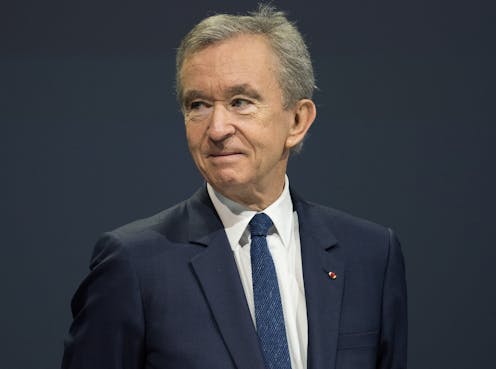keeping it in the family when you’re the world’s richest man
- Written by Qing Wang, Professor of Marketing and Innovation, Director, Marketing Innovation and The Chinese and Emerging Economies (MICEE) Network, Warwick Business School, University of Warwick

In the high end world of luxury and heritage, many brands are still owned and managed by the original founding family. The issue of succession planning, therefore, can be particularly important. This recently came to the fore for founder of the world’s largest luxury conglomorate, LVMH, and the wealthiest man on the planet[1], French billionaire Bernard Arnault.
There’s been much speculation over Arnault’s succession plan. The 75-year-old chairman and CEO of LVMH had his retirement age raised from 75 to 80 in 2022, which should keep him at the helm of the €440 billion (£377 billion) empire for another couple of years at least. LVMH is home to Louis Vuitton, Christian Dior and Givenchy, among many other top-end brands, and generated a cool €86.2 billion in sales in 2023.
This month, two more[2] of Arnault’s five children were appointed to the LVMH board at the conglomorate’s AGM in Paris. The move leaves just one offspring, youngest son Jean, without a seat (although he is employed at the firm). It also gives the family 48.6% of LVMH’s share capital and 64.3% of the voting rights.
Luxury brands often use their heritage as a selling point. With the globalisation of the sector, the nature of luxury consumption is changing[3]. Succession planning allows the infusion of fresh perspectives and ideas, and helps the brand to be agile and adapt to evolving tastes and trends. The two latest Arnault appointments are young – aged just 29 and 31.
A well-executed succession plan also provides stakeholders with a sense of stability and confidence in the business’s trajectory, mitigating uncertainties and fostering trust in the brand’s resilience.
LVMH isn’t the sole luxury brand with familial management. Others, including Hermès, Chanel, Prada, Zegna and Ferragamo also adhere to this tradition. But LVMH stands out as the largest multi-brand luxury conglomerate predominantly controlled by a single family.
The company boasts a glittering portfolio of brands, each with its own storied heritage and cultural significance. From Louis Vuitton’s iconic monogram to Moët & Chandon’s legacy in the champagne world, LVMH’s brands collectively project an image of luxury craftsmanship and artistry. Other major brands under the LVMH umbrella include Fendi, Celine, Bulgari, Hublot and TAG Heuer.
Multi-brand luxury conglomerates enjoy distinct advantages, including economies of scale, diversified revenue streams and increased bargaining power with suppliers and retailers. But there are also unique challenges compared to mono-brand enterprises.
First, harmonising brand identities and ensuring consistency across product lines and market segments poses a formidable task. Each brand boasts its own lineage, ethos and customer base, which need to be carefully navigated to preserve individual identities.
Resource allocation across brands with diverse needs demands a delicate equilibrium. Investment decisions must align with each brand’s growth potential, market positioning and strategic objectives, while also safeguarding the conglomerate’s overall financial health and longevity.
Internal competition between the brands for market share, resources and talent means there needs to be clear delineation of roles and mechanisms. Collaboration without encroaching on brand autonomy is the name of the game.
The family strategy
Arnault’s career[4] at LVMH spans several decades, marked by bold acquisitions and strategic expansions. Under his stewardship, LVMH has emerged as a global powerhouse. In his succession plan, Arnault has strategically positioned his children – Antoine, Delphine and Alexandre – in key leadership roles within the company.
Antoine Arnault, the eldest son, has emerged as a prominent figure within the firm, responsible for guiding the strategic direction of LVMH’s retail businesses. Delphine Arnault, the eldest daughter, holds an important position within LVMH’s fashion division, which encompasses some of the world’s most iconic luxury brands.
As the executive vice president of Louis Vuitton, Delphine oversees the strategic development and expansion of the brand. Alexandre Arnault has been entrusted with spearheading LVMH’s technology and digital initiatives, reflecting the conglomerate’s approach to innovation and growth.
The Roy name was tied to media rather than luxury goods but the succession complexities were the same.Looking outside
While sometimes it can pay dividends to keep things in the family, considering the challenges associated with heritage conglomerates such as LVMH, appointing an external leader can offer certain advantages. External leaders bring fresh perspectives and impartiality, unhampered by tricky familial biases or dynamics. This impartiality can be invaluable in navigating intra-group conflicts, fostering collaboration between brands and propelling innovation.
Bringing in an outsider can also mitigate risks tied to family dynamics, such as conflicts of interest or succession-related tensions, fostering a meritocratic culture where qualifications and performance are given priority. But when a brand is so closely tied to one family name, introducing an external leader may lead to resistance from family members worried about a departure from tradition.
Plus, the process of assimilating an external leader into the organisation’s ethos[5] and aligning their vision with long-term strategic objectives can be a fine line to tread, and stakeholders must also be on board.
Succession planning in the luxury sector is a complex process that requires a careful balance of tradition, innovation and leadership. It serves as a custodian of the brand’s essence and a safeguard of its legacy in a complex marketplace. Getting the succession plan right, whether that means keeping things in the family or looking outside for new leadership, is crucial to maintain continuity and prosperity.
References
- ^ wealthiest man on the planet (www.statista.com)
- ^ two more (www.voguebusiness.com)
- ^ nature of luxury consumption is changing (academic.oup.com)
- ^ career (www.investopedia.com)
- ^ organisation’s ethos (www.mckinsey.com)







